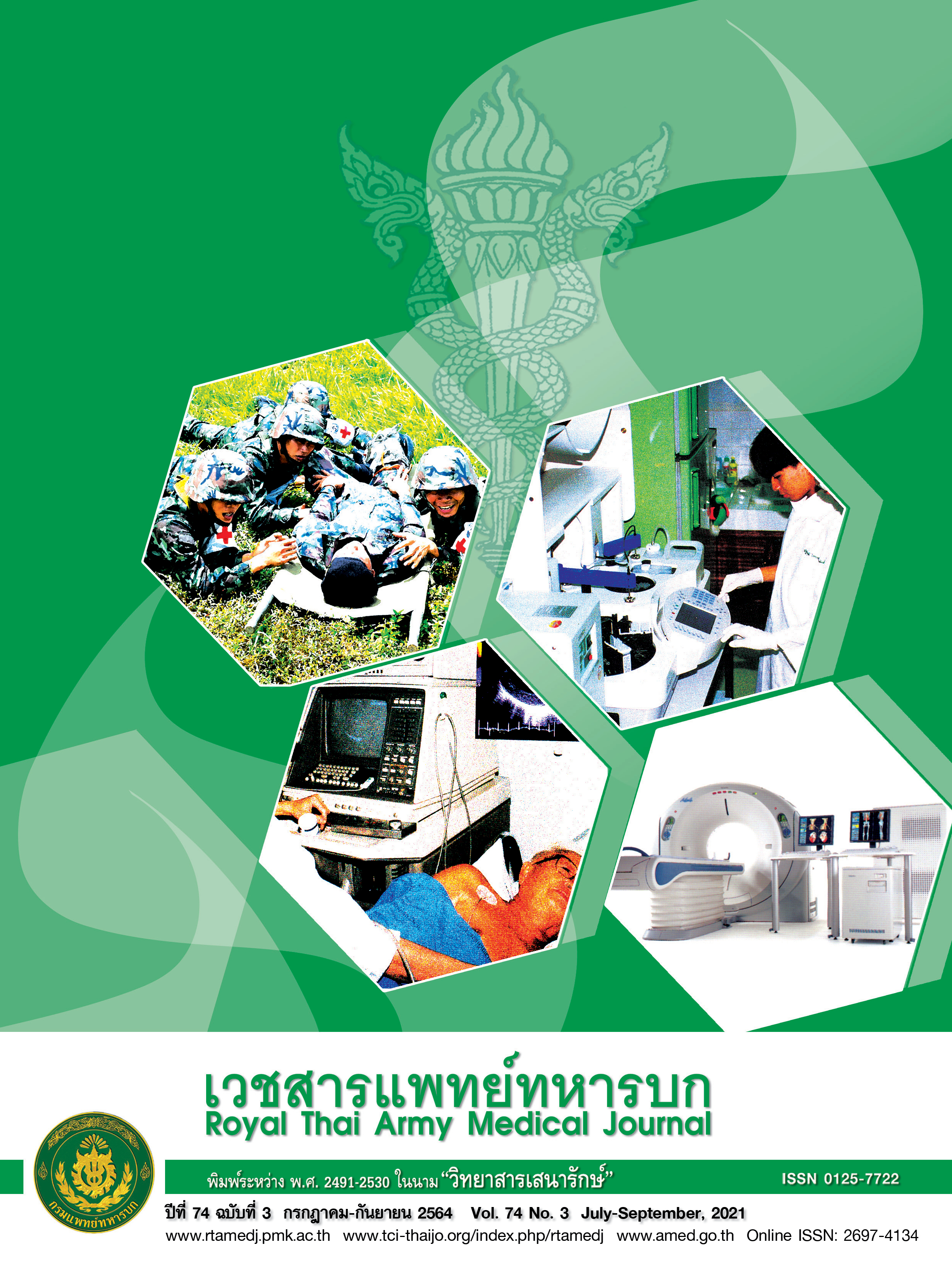Whole Exome Sequencing (WES) Identified ALMS1 Mutation in a Thai Boy with Alström syndrome-A First Report at Phramongkutklao Hospital
Main Article Content
Abstract
Alström syndrome (ALMS) is a rare autosomal recessive multi-system disorder with a phenotypic variability and is characterized by cone-rod dystrophy, sensorineural hearing loss, obesity, insulin resistance/type 2 diabetes mellitus (T2DM), cardiomyopathy and progressive pulmonary, hepatic and renal dysfunction. ALMS is caused by mutations in the Alström syndrome protein 1 (ALMS1) gene. Herein, we report a 15-year-old Thai boy with ALMS presenting with childhood onset retinal degeneration, obesity with T2DM, hypertriglyceridemia and non-alcoholic steatohepatitis, sensorineural hearing loss and dilated cardiomyopathy (DCM). Whole exome sequencing (WES) of the patient’s genomic DNA identified two compound heterozygous mutations including one frameshift mutation; c.6166_6167dup or p.Leu2057PhefsTer17, in exon 8 and one nonsense mutation; c.10822C>T or p.Arg3608Ter, in exon 16 of ALMS1 gene. Both mutations were predicted to result in either absence or truncation of ALMS1 proteins. This report highlighted the clinical utility of WES as a powerful tool for diagnosis of genetic heterogeneity disorders and the rare diseases including ALMS.
Downloads
Article Details
Articles in this journal are copyrighted by the Royal Thai Army Medical Department and published under the Creative Commons Attribution-NonCommercial-NoDerivatives 4.0 International (CC BY-NC-ND 4.0) license.
may be read and used for academic purposes, such as teaching, research, or citation, with proper credit given to the author and the journal.
Use or modification of the articles is prohibited without permission.
Statements expressed in the articles are solely the opinions of the authors.
Authors are fully responsible for the content and accuracy of their articles.
Any other republication of the articles requires permission from the journal.
References
2. Alstrom CH, Hallgren B, Nilsson LB, Asander H. Retinal degeneration combined with obesity, diabetes mellitus and neurogenous deafness: a specific syndrome (not hitherto described) distinct from the Laurence-Moon-Bardet-Biedl syndrome: a clinical, endocrinological and genetic examination based on a large pedigree. Acta Psychiatr Neurol Scand Suppl. 1959;129:1-35.
3. Hearn T, Renforth GL, Spalluto C, Hanley NA, Piper K, Brickwood S, et al. Mutation of ALMS1, a large gene with a tandem repeat encoding 47 amino acids, causes Alström syndrome. Nat Genet. 2002;31(1):79-83.
4. Collin GB, Marshall JD, Ikeda A, So WV, Russell-Eggitt I, Maffei P, et al. Mutations in ALMS1 cause obesity, type 2 diabetes and neurosensory degeneration in Alström syndrome. Nat Genet. 2002;31(1):74-8.
5. Collin GB, Marshall JD, King BL, Milan G, Maffei P, Jagger DJ, et al. The Alström syndrome protein, ALMS1, interacts with α-actinin and components of the endosome recycling pathway. PloS one. 2012;7(5):e37925.
6. Marshall JD, Beck S, Maffei P, Naggert JK. Alström syndrome. Eur J Hum Genet. 2007;15(12):1193-202.
7. Marshall JD, Hinman EJ, Collin GB, Beck S, Cerqueira R, Maffei P, et al. Spectrum of ALMS1 variants and evaluation of genotype-phenotype correlations in Alström syndrome. Hum Mutat. 2007;28(11):1114-23.
8. Marshall JD, Muller J, Collin GB, Milan G, Kingsmore SF, Dinwiddie D, et al. Alström syndrome: mutation spectrum of ALMS1. Hum Mutat. 2015;36(7):660-8.
9. Rethanavelu K, Fung JLF, Chau JFT, Pei SLC, Chung CCY, Mak CCY, et al. Phenotypic and mutational spectrum of 21 Chinese patients with Alström syndrome. Am J Med Genet A. 2020;182(2):279-88.
10. Jinda W, Taylor TD, Suzuki Y, Thongnoppakhun W, Limwongse C, Lertrit P, et al. Whole exome sequencing in eight Thai patients with Leber Congenital Amaurosis reveals mutations in the CTNNA1 and CYP4V2 genes. Invest Ophthalmol Vis Sci. 2017;58(4):2413-20.


